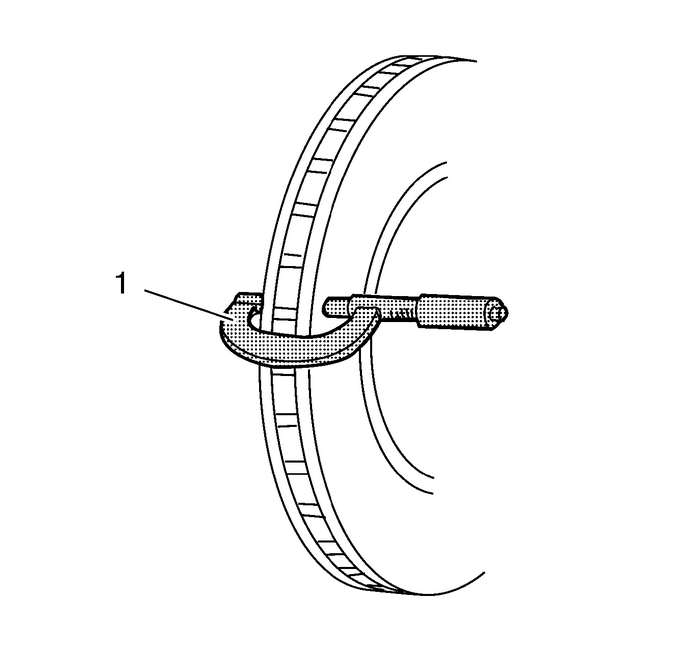Chevrolet Equinox Service Manual: Brake Rotor Thickness Variation Measurement Disc Brakes Brake Rotors
Warning:Refer toBrake Dust Warning.
Note:Any disc brake rotor that exhibits thickness variation exceeding the maximum acceptablelevel must be refinished or replaced. Thickness variation exceeding the maximum acceptablelevel can cause brake pulsation.
If the inboard friction surface of the brake rotor is not accessible, reposition andsupport the caliper with the brake pads. Refer toFront Disc Brake Pads Replacementand/orRear Disc Brake Pads Replacement.Clean the friction surfaces of the brake rotor with denatured alcohol, or an equivalentapproved brake cleaner.
Using a micrometer-(1)-calibrated in thousandths-of-a-millimeter, or ten-thousandths-of-an-inch,measure and record the thickness of the brake rotor at 4 or more points, evenly spacedaround the rotor.
Ensure that the measurements are only taken within the friction surfaces and thatthe micrometer is positioned the same distance from the outer edge of the rotor, about13-mm (½-in), for each measurement.
Calculate the difference between the highest and lowest thickness measurements recordedto obtain the amount of thickness variation.Compare the thickness variation measurement to the following specification:Specification
Brake rotor maximum allowable thickness variation: 0.025-mm (0.001-in)
Note:Whenever a brake rotor is refinished or replaced, the assembled lateral runout (LRO)of the rotor must be measured to ensure optimum performance of the disc brakes.
If the brake rotor thickness variation measurement exceeds the specification, therotor requires refinishing or replacement. Rear Disc Brake Mounting and Hardware Inspection Disc Brakes
Rear Disc Brake Mounting and Hardware Inspection Disc Brakes
Warning:Refer toBrake Dust Warning.Inspect the fluid level in the brake master cylinder reservoir.If the brake fluid level is midway between the maximum–full point and the minimumallowable level the ...
 Park Brake Hardware Inspection Parking Brake
Park Brake Hardware Inspection Parking Brake
Warning:Refer toBrake Dust Warning.With the brake rotors removed, visually inspect the upperreturn/adjuster actuator spring and the lower return spring for thefollowing:Excessive corrosionExcessive st ...
Other materials:
Diesel Particulate Filter
The engine is equipped with a
Diesel Particulate Filter (DPF) that,
by design, will filter or trap
particulates. The DPF is under the
vehicle in the exhaust system.
Depending on a number of factors
monitored by the engine computer,
the DPF will need to be cleaned of
accumulated solids. Whe ...
